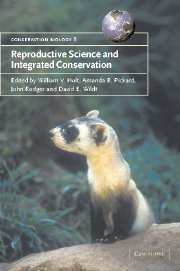Book contents
- Frontmatter
- Contents
- List of contributors
- Foreword
- Part I Introduction
- Part II Reproduction and population viability
- 2 Behaviour and reproduction
- 3 Nutrition and its interaction with reproductive processes
- 4 Environmental chemicals and the threat to male fertility in mammals: evidence and perspective
- 5 Assessing the consequences of inbreeding for population fitness: past challenges and future prospects
- 6 Impacts of inbreeding on components of reproductive success
- 7 The major histocompatibility complex (MHC) in declining populations: an example of adaptive variation
- 8 When is the birth rate the key factor associated with population dynamics?
- Part III Reproductive techniques for conservation management
- Part IV Integrated conservation management
- Part V Reproduction science in non-mammalian species
- Part VI Conclusions
- Index
- References
2 - Behaviour and reproduction
Published online by Cambridge University Press: 21 January 2010
- Frontmatter
- Contents
- List of contributors
- Foreword
- Part I Introduction
- Part II Reproduction and population viability
- 2 Behaviour and reproduction
- 3 Nutrition and its interaction with reproductive processes
- 4 Environmental chemicals and the threat to male fertility in mammals: evidence and perspective
- 5 Assessing the consequences of inbreeding for population fitness: past challenges and future prospects
- 6 Impacts of inbreeding on components of reproductive success
- 7 The major histocompatibility complex (MHC) in declining populations: an example of adaptive variation
- 8 When is the birth rate the key factor associated with population dynamics?
- Part III Reproductive techniques for conservation management
- Part IV Integrated conservation management
- Part V Reproduction science in non-mammalian species
- Part VI Conclusions
- Index
- References
Summary
INTRODUCTION AND OBJECTIVES
A distinguished student of human sexuality, John Money (1991), has commented that ‘Reproduction is more respectable than sex. Reproductive biologists and sexologists seldom attend the same meetings or publish together in the same journals.’ To some extent this bias against studies of behaviour, and especially studies of sexual behaviour, has also affected research on animal reproduction. However, the tide has begun to turn over the past two decades, and there are several reasons for this. Gamete biologists have begun to collaborate with behavioural scientists in order to explore the role played by ‘sperm competition’ and ‘cryptic female choice’ in the evolution of sexual behaviour and mating systems (Eberhard, 1985, 1996; Birkhead & Møller, 1992, 1998; Dixson, 1998). Stronger links have also been forged between behavioural biology and endocrinology; the emerging field of socioendocrinology seeks to understand relationships ‘between social environment, hormones and behaviour, because they modulate the reproductive success of individuals’ (Bercovitch & Ziegler, 1990). Finally, behavioural ecologists have taken a renewed interest in exploring the mating systems and mating tactics of a wide range of animals, especially because modern genetic techniques have made it possible to determine paternity and to measure the reproductive success of individuals in free-ranging populations (Davies, 1991; Martin et al., 1992; Birkhead & Møller, 1992).
Multiple relationships between behaviour and reproduction are illustrated in a schematic fashion in Figure 2.1.
- Type
- Chapter
- Information
- Reproductive Science and Integrated Conservation , pp. 24 - 41Publisher: Cambridge University PressPrint publication year: 2002

